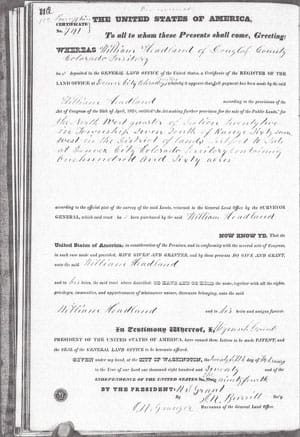LOST AND FOUND: THE SAGA OF WILLIAM HEADLAND

The deed (homestead patent) granted to William Headland for the NW Section 22, of Township 7 South on Range 67 West on February 25, 1870 for his cash payment of $200. The transfer was authorized by Ulysses S. Grant.
By Joe Gschwendtner; photo courtesy of The Bureau of Land Reclamation (U.S. Government)
William Headland was an early homesteader in the Castle Pines Village area. Having paid $200 cash for his 160 acres in 1870, his holdings centered on Saxon Place. By 1880 he had comfortably settled in on his ranch and found himself a woman.
Life in the mountain west was Hobbesian: nasty, brutish, and short. Thus, when The Castle Rock Journal reported his disappearance in November 1885, his details appeared among other brawls, abductions, suicides and murders. Headland had recently agreed with his wife that due to her failing health, they would move to Dade County, Missouri to start a new chapter with her in the family home. A September sale of their Douglas County ranch fetched $7,000. He gave $2,000 of it to her to enable her to precede him to Greenfield, Missouri to prepare their new home.
Months elapsed and he did not appear. As a result, Mrs. Headland traveled to Denver initiating a search, beginning at the Carr House where her husband had last been seen. There she learned Headland had sold another piece of property for $1,000 and then withdrew $3,400 from an account at the German National Bank. With nearly $10,000 on his person when last seen, an assault and murder became the likely scenario.
In describing her husband to the authorities, Mrs. Headland noted he was 52 years old, stout, 5 feet 9 inches tall, blue eyes, sandy hair and beard. Unique to him were his “very heavy eyebrows which grew toward his nose. Ordinarily his eyes appear to be nearly closed.”
For two-and-a-half years it was the opinion of many in Douglas County that Mr. Headland had been murdered and the body buried. That was until Mrs. Headland, acting on anonymous information received, sailed to England. Arriving there in May 1888, she made a beeline to a home in Donnington, Lincolnshire.
Mrs. Headland knocked on the door at dinnertime and was greeted by a 62-year-old woman with William Headland behind her, eating dinner. The dinner ended abruptly when William told Mrs. Headland she was not wanted. She replied by telling him that she had come to settle with him. Headland advised that he would provide her an amount required by law.
As matters played out, she was awarded $155 dollars and a promise to pay her $100 annually. The basis of the meager settlement would appear to be that Headland was not married to the English woman nor had he been married to the woman claiming to be his wife.
His comments on the record were that “I was a bachelor when I arrived here, and I am a bachelor now.” His defense, apparently successful, likely meant his Douglas County wife had been ruled a common law wife with limited rights. The judgment also noted that “Mrs. Headland” was not indigent as she was then living in a Missouri home which she owned outright. And then they went their separate ways…
Wildcat Lore
As it turns out, The Connection serves residents of the Wildcat Mountains, a name pioneers and historians gave to the high country paralleling I-25 from Highlands Ranch and Lone Tree south to Castle Rock. Since the first territorial road (Daniels Park Road) bisected our mountains, there was no shortage of colorful characters parading through what are now private properties on the ridges of Douglas County. We bring these grizzled and gutsy settlers alive again, vividly sharing their stories of grit and achievement in these Castle Pines.
